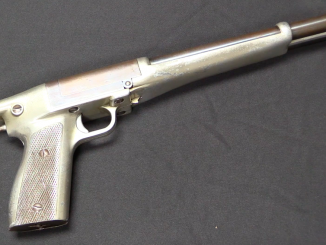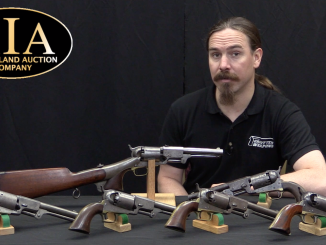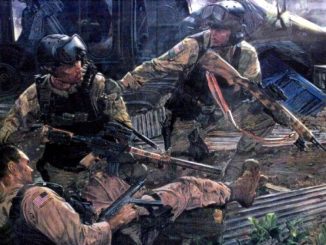I ran across this brief article from the September 17, 1896 edition of the New York Times. They seem to have gotten things pretty well figured out…
THE NEW SMOKELESS POWDER
Change of Tactics Made Necessary to the Army – Effect on Artillery and Cavalry
From The Baltimore Sun
The adoption of the new powder by the army will necessitate alterations in the tactics applying to operations on the field of battle. The infantryman who fires with this powder at once obtains the advantage of having a clear field of fire. But, on the other hand, if he is unprovided with cover, either natural or artificial, there will be no protecting cloud of smoke to conceal him, and should the enemy have found cover, he, on his side, is more vulnerable than when the smoke showed his position. The supposition that troops can be exposed to fire without knowing whence it comes is more or less fanciful in the opinion of Gen. Miles and the best military tacticians in Washington.
It is admitted that with the suppression of smoke the advance against a position will no doubt be somewhat more difficult than formerly, but the danger will not be greater until within 500 or 600 yards of the enemy. Beyond this point, when distances can be judged with less difficulty, when the errors of aiming are small, and where the trajectory of the bullets of the new army gun [ed: the .30-40 Krag] will be altogether dangerous it will make little difference, the experts say, whether smokeless or non-smokeless powder is used. With high-powered guns, capable of terrific velocities and greater accuracy than the old wartime pieces, it will be of the greatest benefit to soldiers to have a clear field, without a cloud of smoke, so that long-distance aiming can be done and a good target made of the enemy. The absence of smoke, the Army says, will be of material advantage to the defender, who can occupy positions which give cover, while those attacking must very often, if not always, advance unconcealed. In some cases formations of the ground might enable them to approach under cover, but these are admitted to be exceptional, and sooner or later he must disclose himself.
Whatever result smokeless powder may have when infantry is fighting it is quite clear to the army that it will exercise considerable influence on the other two arms, the artillery and cavalry. The advantages which it will confer on the artillery are set forth by ordnance officers as follows: it leaves a clear field of fire, and will render it possible, therefore, when firing upon artillery to distinguish the guns from the intervals and to keep the fire of one’s own guns directed on the former. The observation of the fire will also be simplified, while with the new powder the effect of projectiles which burst in the rear of the smoke caused by the enemy’s guns could not be seen. The effect of long-range fire will also be as easily observed as at short. When the artillery is employed in an open country, it will be more difficult to conceal it, while the smoke formerly screened it from view. The movements of batteries, it is claimed, will be more difficult, since no advantage can be taken of the smoke to conceal them.
It is possibly an exaggeration to say, as many officers have who look upon the introduction of smokeless powder as necessitating a direct change in the present tactics, that the cavalry will be rendered valueless on the battlefield. This same opinion was expressed, the army men say, when firearms were introduced, and still the cavalry remains an important factor in all military organizations. Some of the closest students of the art of war contend that the cavalry will not appear on the battlefield in the next great wars,but will be reserved solely to screen the infantry and for reconnoitering purposes. Others contend that as men on horses are higher above the ground than infantrymen, they have better opportunities of seeing what is before them regardless of smoke clouds and that when the time comes for the cavalry to act it makes no difference whether the enemy is concealed by waves of black smoke or standing in plain view.




Thats it, I’m inventing a time machine.
I had no idea the black powder smoke was that important back then.
That smoke was important to people ignorant of the changing nature of war. Black powder smoke may offer concealment, but the powder itself is not something I’d like to handle. It’s unstable, corrosive, and best used very quickly after production. The smoke itself may hide people, but it would make the area a good target for artillery barrages.
In 1886, France made the Lebel rifle with the first smokeless powder cartridge. Smokeless powder has a higher pressure curve during burning and offers more propulsive power per unit volume compared to black powder. It is safer to handle and will not corrode gun barrels as quickly as black powder.
If you’ve ever seen a black powder shoot on a windless day you’d understand ;).
What surprises me is the discussion on battlefield use of the cavalry. The US was already using their cavalry mainly as mounted infantry, to fight dismounted with their carbines as main weapons. The last time large cavalry formations were used in battle was during the German-French war (Mars-la-Tours being the most famous), but even then the cavalry was usually just used to cover infantry during retreats (by both sides). Cavalry charges on prepared infantry lines were suicidal even with single shot black powder needle guns.
Something on the order of one million cavalrymen engaged in the Polish-Soviet War of 1920. All of the critical strikes in this pivotal conflict were led by cavalry. The mobility afforded by horses prevented a mass slaughter akin the the Western Front in WW I.
This certainly manifested itself during the Spanish American war, not 2 years after the article’s publication, when US troops armed with blackpowder .45-70 Springfields were easily spotted by and fired on by Spanish troops armed with the new smokeless 7×57 Mauser cartridge.
also: the concept of smoke grenades or smoke fire screens would have been known at that time i imagine?
A date would be nice. It must be from 1880p1900
Wehen the sailwar ships, were fighting, they somtimes had to stop firing , until they could see eatc other again
Peter, the article was written on 9-17-1896 (use American date convention month, day, year). Funny enough, Sept. 17 is my birthday.
Yes, you are right about ships of the line having to pause if there was too much smoke, but I doubt that happened often. The wind would blow the smoke away. But by this 1896, pre-dreadnought battleships, cruisers of all sizes, destroyers and what not could be using smokeless powder in their main guns. Ships of the line (either sailing frigates or steam-powered wooden ships of similar configuration) were obsolete.
Let us create a strange naval confrontation. On one side, we have ships of the line, powered by steam but fitted with sail masts for your convenience (thus putting us in the 1860’s). On the other, we will have a few pre-dreadnought era torpedo boats. While the bigger line ships have more guns (though they are very big muzzle-loaders), the torpedo boats (armed with torpedoes, quick-firing artillery no bigger than six-pounders, and rifle-caliber machine guns) will have the advantage of speed and killing power.
Why is it funny enough?
http://en.wikipedia.org/wiki/Birthday_problem
😉
Ian might be showing sone of the research he did for his upcoming speech on how arms technology changed war. Thinking back to that thread, I don’t recall anyone suggesting the black powder to smokeless transition as being an advanecement that changed tactics and war in general, etc., but indeed it was. Forget smoke screens, how well would machine guns work if they fired black powder that gunked up the works in short order, at least, how well would it work with enclosed gas pistons? (Browning did make a 45-70 machine gun, but a potato digger I think.)
One side effect that comes to mind from this was that black powder can be made from scratch with three ingredients, none of which are hard to come by. Given a supply of sulphur, any country could set up a factory. There were even some mountain men and such who made their own in an old cast iron pot. Not so with smokeless, that is a different thing entirely in terms of ingredients and technology. Sharpe’s Handloading gives a good snap shot of what it took to make smokeless powder circa 1945. It is something only countries with significant arms industry can justify.
“Modern Hand Loading” By Maj. George C. Nonte Jr. is another book on the subject and describes the process and history at length.
There’s some pretty good old stuff, including English translations of a paper by Mendeleyev (the periodic table man) discussing his work on nitrocellulose propellants, over on archive.org
https://archive.org/details/smokelesspowdern00bernrich
As far as low battlefield signature is concerned, smokeless powder has certainly proven its worth many times over, even at relatively close ranges.
As just one example of many, Japanese snipers in the Pacific War were extremely hard to locate, even after repeated shots, at the relatively close ranges associated with jungle warfare due in large part to the use of smokeless and flashless powder in their Arisaka rifles. When combined with good tactical deployment, outstanding marksmanship and excellent camouflage skills, the lack of muzzle flash and smoke made them formidable antagonists who were very difficult to identify and eliminate.
From what I’ve heard, it came to the point that the Marines would promptly hose down every tree (a favorite hiding place for snipers) in sight with machine gun fire after they were on the beach. Why wait for a sniper to shoot when there are several boat loads of .30 cal ammo and 1919 machine guns coming in to resupply? People scoff at how many rounds were fired in WWII for the number of enemy hit, but as long as one isn’t going to run out, a few cases of ammo fired to possibly save one Marine is worth it.
To confirm what you heard, there is a photo on the web taken at the battle of Buna, New Guinea, which shows an Australian-crewed M3 Stuart tank spraying snipers with its hull-mounted M1919 firing at a very high angle. The caption explains that this tank fired 10,000 rounds, in this way, in one morning. Good little guns those Brownings!
Be careful! The Japanese, just like the Germans, were in the habit of using their heavy anti-air guns as anti-tanks too! If your Stuart tank got within striking distance of a Type 88 75 mm gun while probing for snipers, the tank would soon be toasted by the armor-piercing shot! Even Sherman tanks were easily trashed by these obsolete airplane-killers. I would hate to imagine the trap.
Japanese snipers with Type 97 Sniper rifles in the trees and bushes, hunting US Marines. Marines call the tanks and spray everything in sight, losing a few men to an enemy they can’t see. Japanese anti-aircraft battery kills the tanks and send the Marines running away screaming mommy?
Andrew, in fact the Japanese garrison at Buna included a battery of 8 Type 88 guns, and also a number of the Allied tanks were destroyed by the Japanese in the battle (there were only a few deployed there), but I don’t know exactly how. Nevertheless the Japanese force was almost annihilated in what was a major victory for the Allies, so the scenario did not eventuate.
That such countermeasures had to be resorted to exactly proves the point about the tactical value of smokeless / flashless powder. When used in conjunction with effective flash hiders, visually locating a properly-camouflaged sniper thus equipped is next to impossible.
One episode of the Wild West Tech series on HC illustrated the change very well. About the time this article was written, a marshal and his deputies went after a gang of outlaws in the “surround their hideout” SOP. Trouble was, the outlaws were outside when the “posse” arrived.
In the ensuing gunfight, one “holdup” nearly made mincemeat out of said marshal and said posse single-handed. Because while everyone else was plugging away with blackpowder loads in Colts, Winchesters, & etc., he was using his brand-new M1895 Winchester in .30-40, with smokeless powder ammunition. Which meant he wasn’t generating a handy cloud of white powder smoke to tell everyone where he was. And he kept moving from cover to cover as he “sniped” everybody on the opposing side, never shooting from the same spot more than once or twice. BTW, his fellow holdups didn’t get away, but he did, being caught a few days later, still with his ’95.
The usefulness of smoke as an obscurant is dubious, anyway. For one thing, while it might make targeting individual soldiers impractical, it’s a great target for massed volley fire or, worse yet, artillery. And volley fire was the default infantry tactic of the day, due to what might be called the “Wellington tradition”.
To say nothing of air attack, which became an “issue” less than two decades after this article was published. A cinematic example comes to my mind.
I was just watching the old SF movie The Trollenberg Terror(1958 British), and near the end an RAF Canberra comes in to give the alien invaders a taste of incendiaries. Pilot calls down to FO on the ground, saying he can’t see anything but a cloud. FO (who outranks him) tells him “bomb the cloud”.
I’d have told him, “That’s a smokescreen the enemy is generating to conceal himself. He’s right under it.”
Any Canberra (and probably ex-wartime Mosquito) jock who’s worth his wings would know how to handle that.
Even before modern night vision and other detection aids, a smokescreen, whether from an Esso generator or an infantry company’s Trapdoor Springfields, was mainly a very large sign saying, “Hi! I’m Over Here! Shoot Me!”
cheers
eon
“Hi! I’m Over Here! Shoot Me!”
I could have sworn I heard Aryeh Nusbacher say that in a documentary.
And then someone got him? It sounds like this taunt:
“We give up, enemy, you’re too scary for us. NOW COME OUT SO WE CAN KICK YOUR BUTTS!”
The literary critic and WWII infantry platoon leader Paul Fussell frequently writes about the ineffectiveness of the US Army from a technical and tactical standpoint during the war. He frequently cites the failure of ammunition manufacturers to produce anything close to “smokeless” powder for rifle and machine gun ammunition, at least as compared to what the Wehrmacht issued to its infantrymen. Has anyone read or of otherwise experienced anything to back Professor Fussell’s assertion?
Wes Harris, When I was in ROTC 70–74, we still had M1 rifles and M1919A6 machine guns in our arms room (as well as M14 and M16 rifles and M60 machine guns). When we had a range day, we were issued ammunition with WW2 and Korean War dates on the ammo boxes. I never noticed a difference in smoke from that and more modern ammunition.
I think Fussell is guilty of “the grass is always greener” syndrome
If anyone misses the smoke screen effect, reload your ammo with Unique powder.
The mention of the Spanish-American War reminds me of the movie “The Rough Riders.” There is a scene where Teddy Rosevelt related that the Army higher-ups tried to get his volunteer regiment to take 45-70’s, “because you can hide behind the smoke”, but he held out for Krag’s. The idea being that Army brass tried to give them obsolete arms by claiming the smoke was really a goid thing. I have a copy of T. Roosevelt’s book at home, need to reread it and see if it really happened; the movie, like they all do, took some liberties.
@ PV October 23, 2013 at 5:19 am
Sorry about not following history too closely. I made the scenario assuming that the tactically (and strategically) suicidal nature of the Imperial Japanese Army’s offensive approach to war wasn’t in effect. Since the Japanese did not experience the horrors of trench warfare during WWI (though they did during the Russo-Japanese War, strangely enough), they did not adapt their weapons or thinking to suit the task at hand.
Our new gun laws in France that have just been made law in september allow anybody to finally own a lebel rifle ‘cat. D2)the first military smokeless powder rifle.
However in order to buy 8mm lebel smokless rounds you must have a hunting licence or belong to a gun club.Cartriges loaded with blackpowder can be bought by anyone. Talk about irony
It’s still one more step in the right direction for respectable firearms enthusiasts and historians — congratulations!
This is the first Christmas since taking my shahadah. I am proud to be Muslim, alhamdulillah, and I am grateful to Allah (swt) for bringing me to Islam. Still, as much as I try to leave the old behind and embrace my new life and responsibilities, there are inevitable times cultures collide and coalesce. Insha Allah, I’ll continue to have Christian friends who respect my heart and my choice.